checking oil CITROEN DISPATCH SPACETOURER 2020 Handbook (in English)
[x] Cancel search | Manufacturer: CITROEN, Model Year: 2020, Model line: DISPATCH SPACETOURER, Model: CITROEN DISPATCH SPACETOURER 2020Pages: 324, PDF Size: 10.89 MB
Page 26 of 324
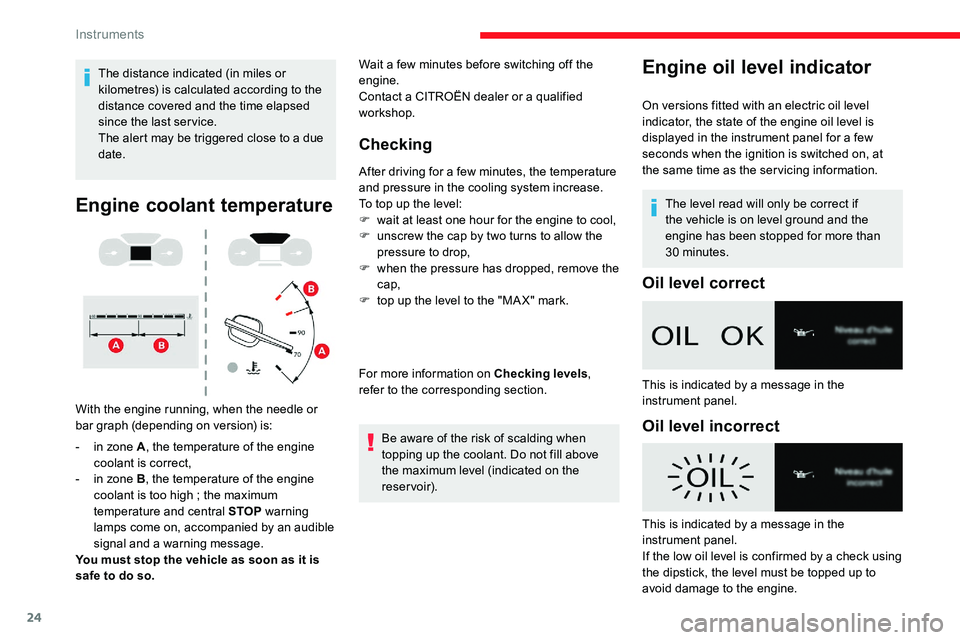
24
The distance indicated (in miles or
k ilometres) is calculated according to the
distance covered and the time elapsed
since the last ser vice.
The alert may be triggered close to a due
date.
Engine coolant temperature
With the engine running, when the needle or
bar graph (depending on version) is:
-
i
n zone A , the temperature of the engine
coolant is correct,
-
i
n zone B , the temperature of the engine
coolant is too high
; the maximum
temperature and central STOP warning
lamps come on, accompanied by an audible
signal and a warning message.
You must stop the vehicle as soon as it is
safe to do so.
Checking
After driving for a few minutes, the temperature
a nd pressure in the cooling system increase.
To top up the level:
F
w
ait at least one hour for the engine to cool,
F
u
nscrew the cap by two turns to allow the
pressure to drop,
F
w
hen the pressure has dropped, remove the
cap,
F
t
op up the level to the "MA X" mark.
For more information on Checking levels ,
refer to the corresponding section.
Be aware of the risk of scalding when
topping up the coolant. Do not fill above
the maximum level (indicated on the
reservoir).
Wait a few
minutes before switching off the
engine.
Contact a CITROËN dealer or a qualified
workshop.
The level read will only be correct if
the vehicle is on level ground and the
engine has been stopped for more than
30
minutes.
Oil level correct
This is indicated by a message in the
instrument panel.
Oil level incorrect
This is indicated by a message in the
instrument panel.
If the low oil level is confirmed by a check using
the dipstick, the level must be topped up to
avoid damage to the engine.
Engine oil level indicator
On versions fitted with an electric oil level
indicator, the state of the engine oil level is
displayed in the instrument panel for a few
seconds when the ignition is switched on, at
the same time as the ser vicing information.
Instruments
Page 193 of 324
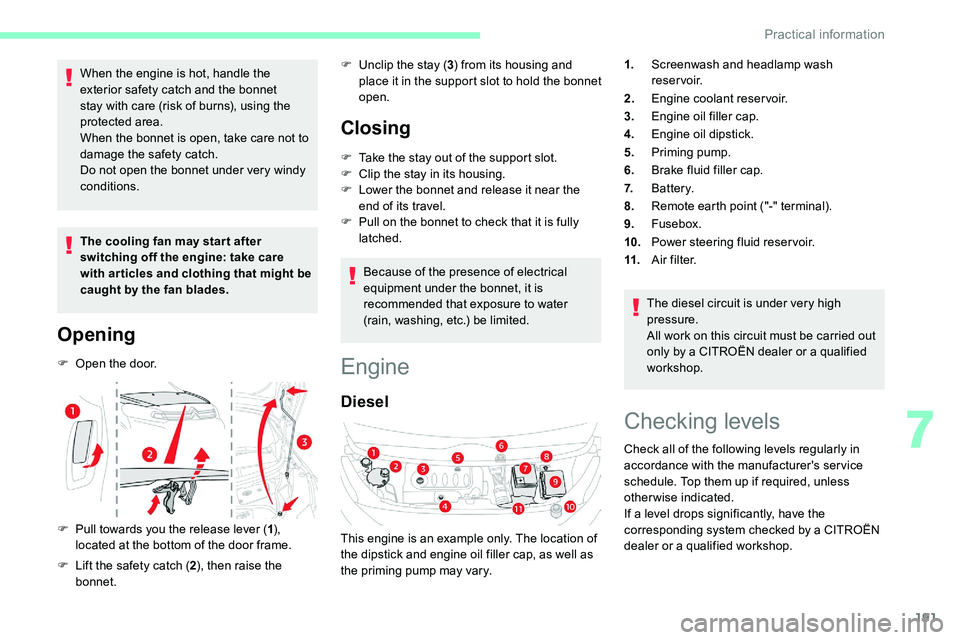
191
When the engine is hot, handle the
exterior safety catch and the bonnet
stay with care (risk of burns), using the
protected area.
When the bonnet is open, take care not to
damage the safety catch.
Do not open the bonnet under very windy
conditions.
The cooling fan may star t after
switching off the engine: take care
with articles and clothing that might be
caught by the fan blades.
Opening
F Open the door.
F
P
ull towards you the release lever ( 1),
located at the bottom of the door frame.
F
L
ift the safety catch ( 2), then raise the
bonnet. F
U
nclip the stay (
3) from its housing and
place it in the support slot to hold the bonnet
open.
Closing
F Take the stay out of the support slot.
F C lip the stay in its housing.
F
L
ower the bonnet and release it near the
end of its travel.
F
P
ull on the bonnet to check that it is fully
latched.
Because of the presence of electrical
equipment under the bonnet, it is
recommended that exposure to water
(rain, washing, etc.) be limited.
Engine
Diesel
The diesel circuit is under very high
pressure.
All work on this circuit must be carried out
only by a CITROËN dealer or a qualified
workshop.
This engine is an example only. The location of
the dipstick and engine oil filler cap, as well as
the priming pump may vary. 1.
Screenwash and headlamp wash
reservoir.
2. Engine coolant reservoir.
3. Engine oil filler cap.
4. Engine oil dipstick.
5. Priming pump.
6. Brake fluid filler cap.
7. Battery.
8. Remote earth point ("-" terminal).
9. Fusebox.
10. Power steering fluid reservoir.
11. A i r f i l t e r.
Checking levels
Check all of the following levels regularly in
accordance with the manufacturer's service
schedule. Top them up if required, unless
otherwise indicated.
If a level drops significantly, have the
corresponding system checked by a CITROËN
dealer or a qualified workshop.
7
Practical information
Page 194 of 324
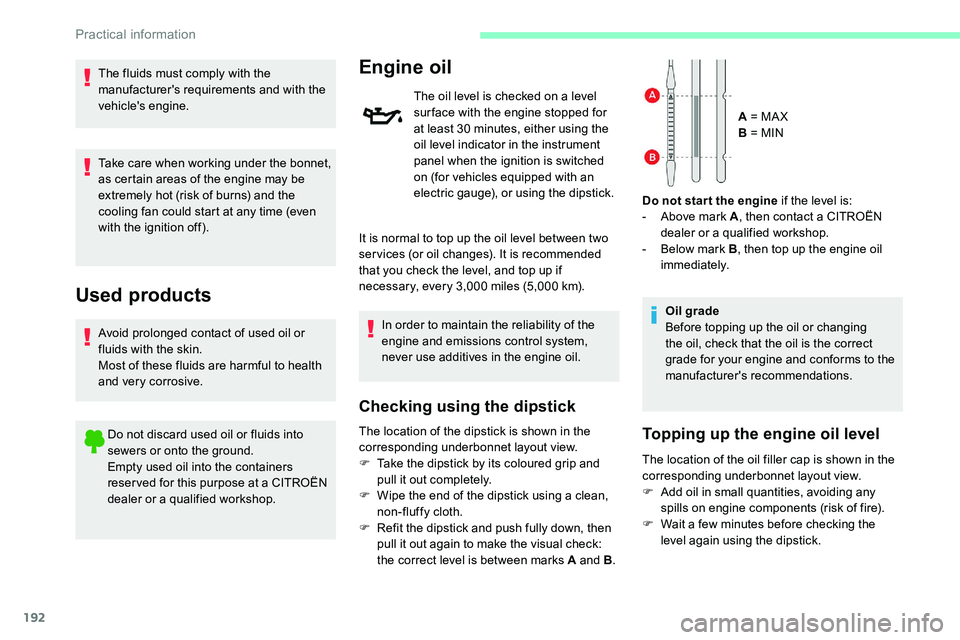
192
The fluids must comply with the
manufacturer's requirements and with the
vehicle's engine.
Take care when working under the bonnet,
as certain areas of the engine may be
extremely hot (risk of burns) and the
cooling fan could start at any time (even
with the ignition off).
Used products
Avoid prolonged contact of used oil or
fluids with the skin.
Most of these fluids are harmful to health
and very corrosive.Do not discard used oil or fluids into
sewers or onto the ground.
Empty used oil into the containers
reser ved for this purpose at a CITROËN
dealer or a qualified workshop.
Engine oil
The oil level is checked on a level
sur face with the engine stopped for
at least 30 minutes, either using the
oil level indicator in the instrument
panel when the ignition is switched
on (for vehicles equipped with an
electric gauge), or using the dipstick.
It is normal to top up the oil level between two
ser vices (or oil changes). It is recommended
that you check the level, and top up if
necessary, every 3,000
miles (5,000 km).
In order to maintain the reliability of the
engine and emissions control system,
never use additives in the engine oil.
Checking using the dipstick
The location of the dipstick is shown in the
corresponding underbonnet layout view.
F
T
ake the dipstick by its coloured grip and
pull it out completely.
F
W
ipe the end of the dipstick using a clean,
non-fluffy cloth.
F
R
efit the dipstick and push fully down, then
pull it out again to make the visual check:
the correct level is between marks A and B .A = MA X
B = MIN
Do not star t the engine if the level is:
-
A
bove mark A
, then contact a CITROËN
dealer or a qualified workshop.
-
B
elow mark B
, then top up the engine oil
immediately.
Oil grade
Before topping up the oil or changing
the oil, check that the oil is the correct
grade for your engine and conforms to the
manufacturer's recommendations.Topping up the engine oil level
The location of the oil filler cap is shown in the
corresponding underbonnet layout view.
F
A
dd oil in small quantities, avoiding any
spills on engine components (risk of fire).
F
W
ait a few minutes before checking the
level again using the dipstick.
Practical information
Page 195 of 324
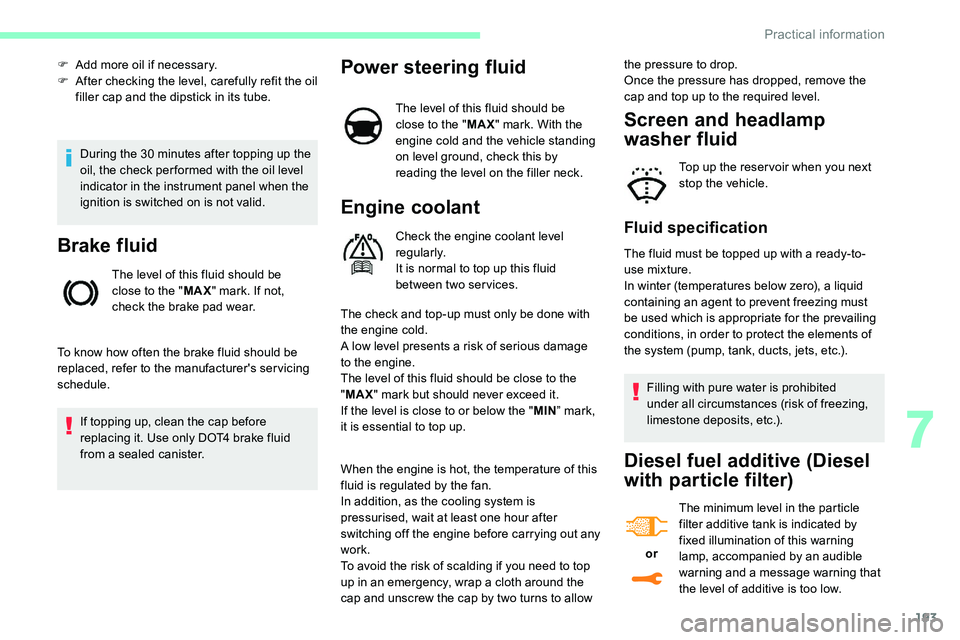
193
During the 30 minutes after topping up the
o il, the check per formed with the oil level
indicator in the instrument panel when the
ignition is switched on is not valid.
Brake fluid
The level of this fluid should be
close to the " MAX" mark. If not,
check the brake pad wear.
To know how often the brake fluid should be
replaced, refer to the manufacturer's servicing
schedule. If topping up, clean the cap before
replacing it. Use only DOT4 brake fluid
from a sealed canister.
F
A
dd more oil if necessary.
F
A
fter checking the level, carefully refit the oil
filler cap and the dipstick in its tube.
Power steering fluid
The level of this fluid should be
close to the " MAX" mark. With the
engine cold and the vehicle standing
on level ground, check this by
reading the level on the filler neck.
Engine coolant
Check the engine coolant level
regularly.
It is normal to top up this fluid
between two services.
The check and top-up must only be done with
the engine cold.
A low level presents a risk of serious damage
to the engine.
The level of this fluid should be close to the
" MAX " mark but should never exceed it.
If the level is close to or below the " MIN” mark,
it is essential to top up. the pressure to drop.
Once the pressure has dropped, remove the
cap and top up to the required level.
Screen and headlamp
washer fluid
Top up the reser voir when you next
stop the vehicle.
Fluid specification
The fluid must be topped up with a ready-to-
use mixture.
In winter (temperatures below zero), a liquid
containing an agent to prevent freezing must
be used which is appropriate for the prevailing
conditions, in order to protect the elements of
the system (pump, tank, ducts, jets, etc.).
When the engine is hot, the temperature of this
fluid is regulated by the fan.
In addition, as the cooling system is
pressurised, wait at least one hour after
switching off the engine before carrying out any
work.
To avoid the risk of scalding if you need to top
up in an emergency, wrap a cloth around the
cap and unscrew the cap by two turns to allow Filling with pure water is prohibited
under all circumstances (risk of freezing,
limestone deposits, etc.).
Diesel fuel additive (Diesel
with particle filter)
or
The minimum level in the particle
filter additive tank is indicated by
fixed illumination of this warning
lamp, accompanied by an audible
warning and a message warning that
the level of additive is too low.
7
Practical information
Page 197 of 324
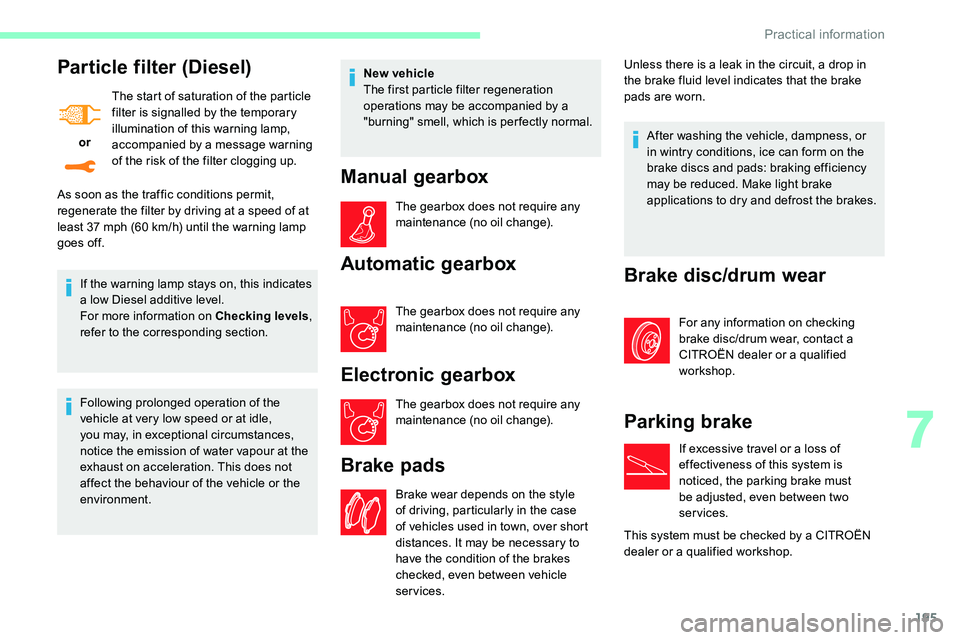
195
Particle filter (Diesel)
or The start of saturation of the particle
filter is signalled by the temporary
illumination of this warning lamp,
accompanied by a message warning
of the risk of the filter clogging up.
If the warning lamp stays on, this indicates
a low Diesel additive level.
For more information on Checking levels ,
refer to the corresponding section.
Following prolonged operation of the
vehicle at very low speed or at idle,
you may, in exceptional circumstances,
notice the emission of water vapour at the
exhaust on acceleration. This does not
affect the behaviour of the vehicle or the
environment. New vehicle
The first particle filter regeneration
operations may be accompanied by a
"burning" smell, which is per fectly normal.
Manual gearbox
The gearbox does not require any
maintenance (no oil change).
Automatic gearbox
The gearbox does not require any
maintenance (no oil change).
Electronic gearbox
The gearbox does not require any
maintenance (no oil change).
Brake pads
Brake wear depends on the style
of driving, particularly in the case
of vehicles used in town, over short
distances. It may be necessary to
have the condition of the brakes
checked, even between vehicle
services.Unless there is a leak in the circuit, a drop in
the brake fluid level indicates that the brake
pads are worn.
As soon as the traffic conditions permit,
regenerate the filter by driving at a speed of at
least 37 mph (60
km/h) until the warning lamp
goes off. After washing the vehicle, dampness, or
in wintry conditions, ice can form on the
brake discs and pads: braking efficiency
may be reduced. Make light brake
applications to dry and defrost the brakes.
Brake disc/drum wear
For any information on checking
brake disc/drum wear, contact a
CITROËN dealer or a qualified
workshop.
Parking brake
If excessive travel or a loss of
effectiveness of this system is
noticed, the parking brake must
be adjusted, even between two
services.
This system must be checked by a CITROËN
dealer or a qualified workshop.
7
Practical information
Page 309 of 324
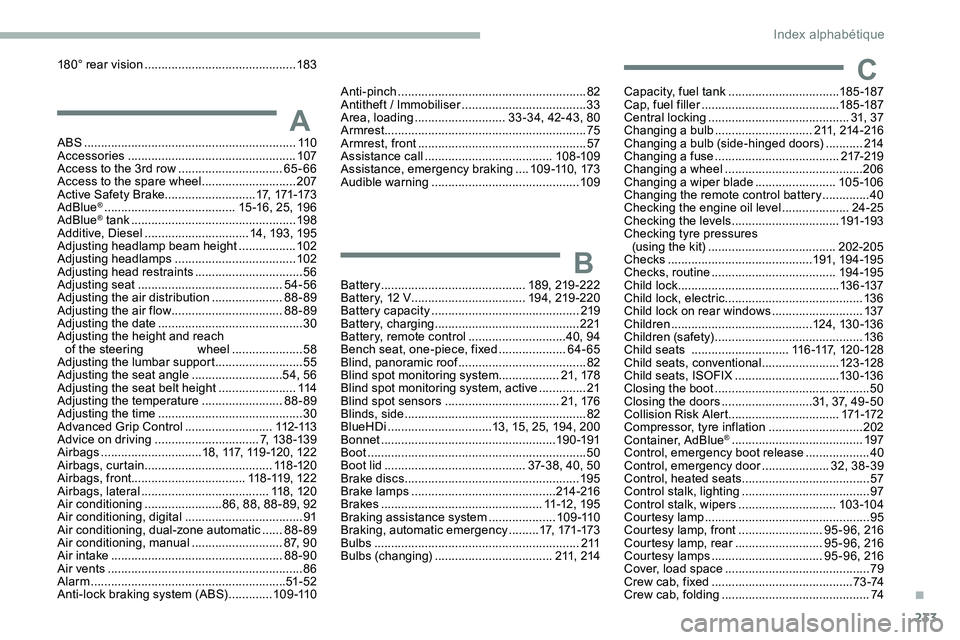
233
ABS ...............................................................11 0
Accessories .................................................. 107
Access to the 3rd row
...............................65-66
Access to the spare wheel
............................207
Active Safety Brake........................... 17, 171-173
AdBlue
® ....................................... 1 5 -16, 25, 196
AdBlue® tank ................................................. 19 8
Additive, Diesel ............................... 14, 193, 195
Adjusting headlamp beam height
................. 10
2
Adjusting headlamps
.................................... 102
Adjusting head restraints
................................ 56
Adjusting seat
........................................... 54-56
Adjusting the air distribution
.....................88-89
Adjusting the air flow
................................. 8
8-89
Adjusting the date
........................................... 30
Adjusting the height and reach of the steering wheel
.....................58
Adjusting the lumbar support
.......................... 55
A
djusting the seat angle
........................... 54, 56
Adjusting the seat belt height
....................... 11
4
Adjusting the temperature
........................88-89
Adjusting the time
........................................... 30
Advanced Grip Control
.......................... 112 -113
Advice on driving
............................... 7, 13 8 -13 9
Airbags
.............................. 1
8, 117, 119 -120, 122
Airbags, curtain
...................................... 11 8 -12 0
Airbags, front .................................. 11 8 -11 9 , 12 2
Airbags, lateral
...................................... 118, 120
Air conditioning
....................... 86, 88, 88 - 89, 92
Air conditioning, digital
................................... 91
Air conditioning, dual-zone automatic
......88-89
Air conditioning, manual
........................... 87
, 90
Air intake
................................................... 88-90
Air vents
.......................................................... 86
Alarm
.......................................................... 51- 5 2
Anti-lock braking system (ABS)
.............109 -110 Anti-pinch
........................................................
8
2
Antitheft / Immobiliser
..................................... 33
A
rea, loading
...........................
3
3 -34, 42- 43, 80
Armrest
................
............................................
75
Armrest, front ..................................................
57
Assistance call
...............................
.......
108 -109
Assistance, emergency braking
....
109 -110, 173
Audible warning
............................................ 10
9Capacity, fuel tank
.................................
185 -187
Cap, fuel filler
...............................
..........
185 -187
Central locking
.......................................... 3
1, 37
Changing a bulb
............................. 21
1, 214 -216
Changing a bulb (side-hinged doors)
........... 2
14
Changing a fuse
..................................... 21
7-219
Changing a wheel
......................................... 20
6
Changing a wiper blade
........................ 10
5 -10 6
Changing the remote control battery
..............
40
Checking the engine oil level ....................
24-25
Checking the levels ................................191-193
Checking tyre pressures (using the kit)
......................................202-205
Checks
...........................................191, 19 4 -195
Checks, routine
.....................................19 4 -195
Child lock
................................................13 6 -137
Child lock, electric
.........................................13 6
Child lock on rear windows
...........................137
Children
..........................................124, 13 0 -13 6
Children (safety)
............................................13 6
Child seats
.............................11
6 -117, 12 0 -12 8
Child seats, conventional
.......................123 -128
Child seats, ISOFIX
...............................13 0 -13 6
Closing the boot
..............................................50
Closing the doors
...........................31, 37, 49 -50
Collision Risk Alert ................................. 171-172
Compressor, tyre inflation
............................202
Container, AdBlue
® ....................................... 19 7
Control, emergency boot release ...................40
Control, emergency door
.................... 3
2, 38 -39
Control, heated seats
...................................... 57
Control stalk, lighting
...................................... 97
Control stalk, wipers
............................. 10
3 -104
Courtesy lamp
................................................. 95
Courtesy lamp, front
......................... 95 - 9 6, 216
Courtesy lamp, rear
.......................... 95 - 9 6, 216
Courtesy lamps
................................. 95 - 9 6, 216
Cover, load space
........................................... 79
Crew cab, fixed
.......................................... 7 3 -74
Crew cab, folding
............................................ 74
A
B
C
Battery ........................................... 189, 219-222
Battery, 12 V ............................... ...19 4, 219 -220
Battery capacity
............................................ 219
Battery, charging
........................................... 221
Battery, remote control
.............................40, 94
Bench seat, one-piece, fixed
.................... 6
4-65
Blind, panoramic roof
...................................... 82
Blind spot monitoring system
..................21, 178
Blind spot monitoring system, active
..............21
Blind spot sensors
.................................. 21, 176
Blinds, side
...................................................... 82
BlueHDi
............................... 13, 15, 25, 194, 200
Bonnet
.................................................... 19 0 -191
Boot
................................................................. 50
Boot lid
.......................................... 37-38, 40, 50
Brake discs
.................................................... 195
Brake lamps
...............................
............214 -216
Brakes
................................................ 11 -12 , 1 9 5
Braking assistance system
....................109 -110
Braking, automatic emergency
.........17, 171-173
Bulbs
............................................................. 2 11
Bulbs (changing)
................................... 211, 214
180° rear vision
.............................................
183
.
Index alphab